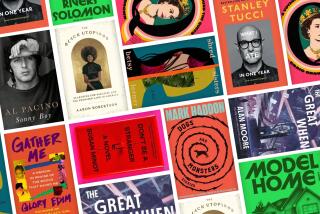Book review: ‘Literary Brooklyn’
Literary Brooklyn: The Writers of Brooklyn and the Story of American City Life
Evan Hughes
Holt Paperbacks: 352 pp., $16
On Sunday in Brooklyn, as people are standing in line to hear Pulitzer Prize winners Jennifer Egan and Jhumpa Lahiri, others will be parking their strollers so Adam Mansbach can sign copies of his alt-parenting book “Go the F-- to Sleep.” The Brooklyn Book Festival has become New York City’s preeminent public daylong literary event — even though it takes place across the river from Manhattan, the epicenter of publishing.
That’s partly because Brooklyn has a reputation for being bookish — it’s got buckets of independent bookstores, and these days you can’t swing a laptop bag in Park Slope without hitting a bestselling novelist. The tradition of writers making their home in the borough stretches back to Walt Whitman, who paced Brooklyn’s early muddy streets preparing to sound his barbaric yawp.
That legacy is traced in the lively new history “Literary Brooklyn” by Evan Hughes, who lays in the facts and brightens them with solid literary critique. Hughes begins with Whitman and works his way forward, giving attention to Norman Mailer, Thomas Wolfe, Truman Capote, Henry Miller, Bernard Malamud, Richard Wright, Arthur Miller, Hart Crane, Marianne Moore, William Styron, Hubert Selby Jr. and more. It’s an impressive lineup, in skill and in scope.
In a way, the literary history of Brooklyn is like a literary history of America itself — not because America is like Brooklyn, which it isn’t, but because it is a story of a certain set of writers describing what they knew as America came into being, as the country invented a literature of its own.
Whitman’s story reaches back to the Revolutionary War: Born in 1819, he had relatives who fought in it, and he was fascinated by some of its tragedies (his longtime advocacy led to the Prison Ship Martyrs’ Monument that still stands in Fort Greene Park). A journalist and iconoclast, Whitman created a poetry like none that had come before and was, essentially, an enthusiastic self-publisher, printing the first run of “Leaves of Grass” by hand. As he does with most of the included authors, Hughes traces Whitman’s movements between homes and workplaces in Brooklyn, which, in the early part of the 19th century, was largely an agrarian port city. People traveled across the East River by ferry until 1883, when the Brooklyn Bridge, a landmark engineering achievement, was completed. The connection tied Brooklyn in new and irrevocable ways to Manhattan, and 15 years later, all five boroughs were united as the city we know today.
Ever since, and even before, Manhattan has loomed large in the writing of Brooklyn. “One experience Brooklyn’s writers have shared,” Hughes writes, “is living just outside the colossal, churning center of the metropolis — across the river from what is still often referred to as ‘the city.’” In one way or another, Brooklyn’s writers have often wound up writing against Manhattan — even if sometimes that meant, as in the case of Malamud and Alfred Kazin, they were writing toward it.
Whitman, Thomas Wolfe and Hart Crane celebrated Brooklyn, as did, in his own way, Henry Miller. Miller, who became famous for writing sexually explicit novels in France, spent his formative years as a boy in Brooklyn’s tough streets. He maintained a fierce affinity for that street culture, returning to it in his later writings.
Yet Malamud, Kazin and the lesser-known Daniel Fuchs had an inverse experience, seeing no benefit to growing up in poverty and feeling a burden in their Jewish immigrant parents’ diminished prospects. To them, getting out of Brooklyn was a goal, and writing was the ticket.
Meanwhile, other writers sought out Brooklyn, for a variety of reasons. For Wright, it was a place where racial lines were permeable, if not perfectly so. For Mailer, it was staking a claim on the borough’s toniest district, Brooklyn Heights. For the residents of the February House, which included Carson McCullers, W.H. Auden and Gypsy Rose Lee, it was cheap rent and a bohemian lifestyle. For others who came later, in the 1980s and ‘90s, it was plain old cheap rent.
Or was it? The flyleaf of “Literary Brooklyn” has a map marked with the homes of the book’s featured authors. Anyone who knows the borough well enough to pick out the Gowanus Canal can find where Paul Bowles or John Dos Passos lived, and the connection becomes immediate, intimate. A teenage Miller walked down the block in Williamsburg where I once lived to moon over a girl who would never have him — that was 80 years before I arrived, but it’s still much the same block. Wright, Moore and Styron walked the same park Whitman once did. The history of writers in Brooklyn is thick on the ground, in the air and even on the streets.
It became a place where writers could soak in history and also community, where on the way to get coffee you might bump into MacArthur “Genius” Fellow Colson Whitehead, Lahiri or Egan, Jonathan Safran-Foer and Nicole Krauss or Jonathan Ames. Like so much of New York, significant parts of Brooklyn have been gentrified out of attracting the younger, broker authors — but if history repeats itself, they’re still coming. It’s a big borough.
More to Read
Sign up for our Book Club newsletter
Get the latest news, events and more from the Los Angeles Times Book Club, and help us get L.A. reading and talking.
You may occasionally receive promotional content from the Los Angeles Times.








